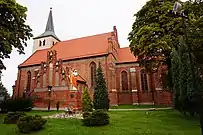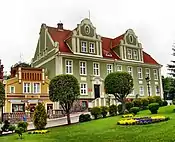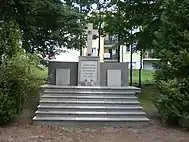Skarszewy
Skarszewy [skarˈʂɛvɨ] (Kashubian: Skarszewò, German: Schöneck in Westpreußen) is a small town 40 kilometres (25 miles) south of Gdańsk in Starogard Gdański County, Pomeranian Voivodeship, northern Poland. It is located between Kościerzyna and Tczew. Population: 6 809 (30 June 2005). In 2005 the town was given the title the Pearl of Pomerania. It is the seat of the urban-rural administrative district Gmina Skarszewy.
Skarszewy | |
|---|---|
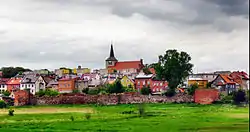 Panorama of Skarszewy | |
 Coat of arms | |
 Skarszewy | |
| Coordinates: 54°4′2″N 18°26′45″E | |
| Country | |
| Voivodeship | Pomeranian |
| County | Starogard |
| Gmina | Skarszewy |
| Established | 12th century |
| Town rights | 1320 |
| Government | |
| • Mayor | Dariusz Skalski |
| Area | |
| • Total | 9.43 km2 (3.64 sq mi) |
| Population (2006) | |
| • Total | 6,824 |
| • Density | 720/km2 (1,900/sq mi) |
| Time zone | UTC+1 (CET) |
| • Summer (DST) | UTC+2 (CEST) |
| Postal code | 83-250 |
| Area code(s) | +48 58 |
| Car plates | GST |
| Website | http://www.skarszewy.pl |
The old town is enclosed by fragments of the 14th century stone walls and a Gothic parish Church of St Michael the Archangel which dates from the 14th century with well-preserved furnishings from the baroque era.
In the town square is the fountain Griffin Pomorski with three griffins holding the emblem of St. John Skarszew on a platter. At the top were placed reproductions of three coats Skarszew: from 1198 when the town belonged to the Knights Hospitaller; from 1320 when Skarszewy acquired civic rights and the current coat of arms.
History
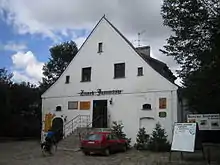
The town was first mentioned as a seat of Knights Hospitaller in 1198. It was part of the medieval Kingdom of Poland until the 14th century. In 1320 it obtained town rights, and in 1370 it was sold by the Order of St. John to the Teutonic Order. In 1454, upon the request of the anti-Teutonic Prussian Confederation, the town was re-incorporated into the Kingdom of Poland by King Casimir IV Jagiellon. During the subsequent Thirteen Years' War, in 1455, it was ravaged by the Teutonic Knights,[1] who finally renounced any claims to the town in 1466. Again within Poland, administratively it was part of the Pomeranian Voivodeship in the province of Royal Prussia in the Greater Poland Province of the Polish Crown.
In 1613 Skarszewy became capital of the Pomeranian Voivodeship. Between 1629 and 1655 it was devastated by the Swedes. Large fires in the years 1708, 1714, 1731 destroyed almost all the buildings. In 1762–1765, Józef Wybicki, the author of the lyrics of the national anthem of Poland, studied law at the local court, located in the old castle.[2] In 1772 the town was annexed by the Kingdom of Prussia in the First Partition of Poland.
Under the Treaty of Versailles Skarszewy was reassigned to Poland, after the country regained independence. The Blue Army (Poland) commanded by General Józef Haller entered Skarszewy on 30 January 1920, ending 148 years of Prussian rule. As part of the Second Polish Republic, administratively it was located in the Pomeranian Voivodeship.
During World War II from 1939 to 1945 it was occupied by Germany. Hundreds of Poles from Skarszewy and surrounding villages were imprisoned in the town, and later massacred in various places during the Intelligenzaktion in October and November 1939. Over 240 Poles, previously imprisoned in Skarszewy, including teachers, merchants, local officials, priests, activists, craftsmen, workers, farmers, were murdered in the nearby forest by the SS, Gestapo and Selbstschutz.[3] Over 100 Poles were murdered in the forest between Skarszewy and Więckowy.[3] The wójt of Gmina Skarszewy, Emil Więcki, was murdered in a massacre carried out in Mestwinowo.[4] The local school principal was among Polish teachers and principals murdered in the Dachau concentration camp.[5] In November 1939, around 1,000 Poles, mostly families of those murdered in the massacres, were expelled to the General Government.[6]
Soviet aircraft repeatedly bombed the city and on March 8, 1945 the Red Army's East Pomeranian Offensive burned parts of the city, causing the destruction of up to 40% of the buildings in Skarszewy. After the war the town was restored to Poland.
In 2012 the town limits of Skarszewy were expanded, by including the settlement of Pólko.[7]
Notable people
- Józef Wybicki (1747–1822), Polish nobleman, jurist, poet, political activist, author of the lyrics of the national anthem of Poland[2]
- Bartłomiej Smuczyński (born 1995), Polish footballer
International relations
Skarszewy is twinned with:
Skarszewy was twinned with Sandy in Bedfordshire, England in 1996. Each year over summer, students from Sandy Secondary School, Stratton Upper School in Biggleswade and Bedford Girls' School in Bedford travel to Skarszewy for twelve days to teach English to some of the younger generation of the town.[9]
| Wikimedia Commons has media related to Skarszewy. |
References
- Marian Biskup, Trzynastoletnia wojna z Zakonem Krzyżackim 1454-1466, Warszawa 1967, p. 327 (in Polish)
- "90 lat Mazurka Dąbrowskiego. Autor Hymnu Narodowego mieszkał w Skarszewach". Kociewiak.pl (in Polish). Retrieved 28 June 2020.
- Maria Wardzyńska, Był rok 1939. Operacja niemieckiej policji bezpieczeństwa w Polsce. Intelligenzaktion, IPN, Warszawa, 2009, p. 153, 183 (in Polish)
- Maria Wardzyńska, Był rok 1939. Operacja niemieckiej policji bezpieczeństwa w Polsce. Intelligenzaktion, p. 154-155
- Maria Wardzyńska, Był rok 1939. Operacja niemieckiej policji bezpieczeństwa w Polsce. Intelligenzaktion, p. 181
- Maria Wardzyńska, Wysiedlenia ludności polskiej z okupowanych ziem polskich włączonych do III Rzeszy w latach 1939-1945, IPN, Warszawa, 2017, p. 49 (in Polish)
- Rozporządzenie Rady Ministrów z dnia 26 lipca 2011 r. w sprawie ustalenia granic niektórych gmin i miast oraz zmiany siedzib władz niektórych gmin, Dz. U. z 2011 r. Nr 158, poz. 937
- "Archived copy". Archived from the original on 2016-03-04. Retrieved 2015-09-04.CS1 maint: archived copy as title (link)
- Archived 2009-05-17 at the Wayback Machine

